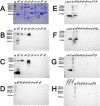Immunoreactivity and neutralization study of Chinese Bungarus multicinctus antivenin and lab-prepared anti-bungarotoxin antisera towards purified bungarotoxins and snake venoms
- PMID: 33253321
- PMCID: PMC7728252
- DOI: 10.1371/journal.pntd.0008873
Immunoreactivity and neutralization study of Chinese Bungarus multicinctus antivenin and lab-prepared anti-bungarotoxin antisera towards purified bungarotoxins and snake venoms
Abstract
Bungarus multicinctus is the most venomous snake distributed in China and neighboring countries of Myanmar, Laos, north Vietnam and Thailand. The high mortality rate of B. multicinctus envenomation is attributed to the lethal components of α-, β-, γ- and κ- bungarotoxins contained in the venom. Although anti-B. multicinctus sera were produced in Shanghai, Taiwan and Vietnam, the most widely clinic used product was term as B. multicinctus antivenin and manufactured by Shanghai Serum Bio-technology Co. Ltd. In the present investigation, high purity α-, β- and γ-bungarotoxins were separately isolated from B. multicinctus crude venom. Rabbit anti- α-, β- and γ-bungarotoxin antisera were prepared by common methods, respectively. LD50 values of α-, β- and γ-bungarotoxins were systematically determined via three administration pathways (intraperitoneal, intramuscular and intravenous injections) in Kunming mice. LD50 values of β-bungarotoxin were closely related with injection routines but those of both α- and γ-bungarotoxins were not dependent on the injection routines. Commercial B. multicinctus antivenin showed strong immunoreaction with high molecular weight fractions of the B. multicinctus but weakly recognized low molecular weight fractions like α- and γ-bungarotoxins. Although B. multicinctus antivenin showed immunoreaction with high molecular weight fractions of Bungarus fasciatus, Naja atra, Ophiophagus hannah venoms but the antivenin only demonstrated animal protection efficacy against O. hannah venom. These results indicated that the high molecular weight fractions of the O. hannah played an important role in venom lethality but those of B. fasciatus and N. atra did not have such a role.
Conflict of interest statement
The authors have declared that no competing interests exist
Figures




References
-
- Naiping Wang, Qibin Li, Bingyi Li, Zhaoyan Li, Huaipeng Li, Shengxi Tang, et al. An epidemiological study on the snakebites in GuangXi province, China in 1990. Journal of Snake. 1993;5(1):10–7.
Publication types
MeSH terms
Substances
LinkOut - more resources
Full Text Sources
Other Literature Sources
Miscellaneous

